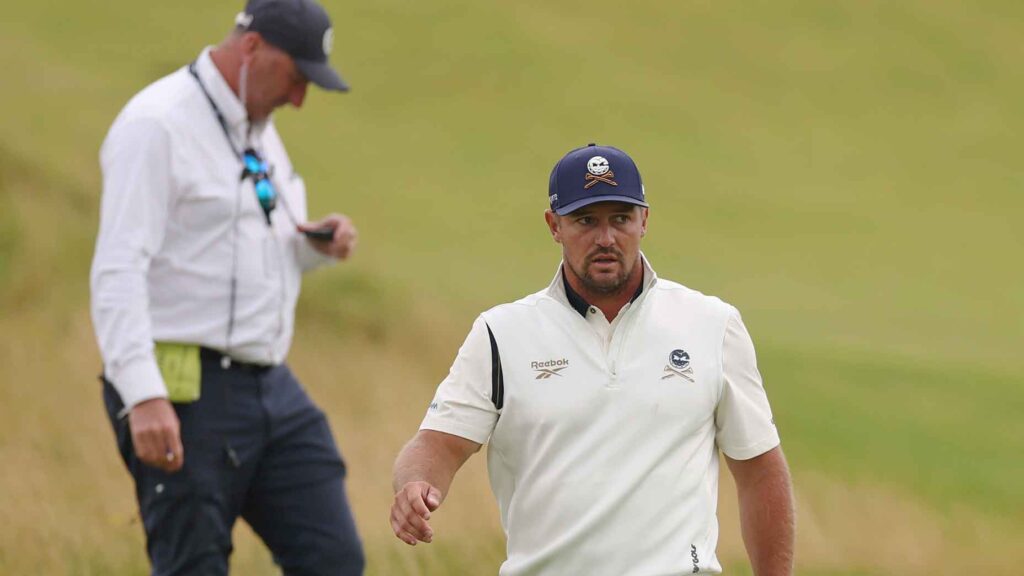Understanding Bryson DeChambeau’s Perspective on Pace of Play in Golf
Introduction
PORTRUSH, Northern Ireland – As the excitement of competitive golf unfolds during high-stakes tournaments, players often grapple with challenges beyond their skills, one of the most pressing being the pace of play. Recently, Bryson DeChambeau, a polarizing figure known for his innovative approach to the game, shared his frustrations during the third round of a championship event. Positioned at a pivotal moment in the tournament, DeChambeau was visibly agitated not just by his performance but by the timing protocols imposed by golfing officials. This incident spotlights a broader issue in professional golf that deserves closer examination.
The Growing Issue of Pace of Play
As one of the hottest topics in professional golf, pace of play affects both player performance and spectator enjoyment. In major championships, rounds exceeding six hours have become alarmingly common due to a myriad of factors: course layout, types of holes, greens speed, and the depth of rough. High-pressure situations, especially those involving Ryder Cup and FedEx Cup implications, exacerbate the situation. Yet, despite ongoing discussions, substantive solutions remain elusive. It’s crucial to explore why this issue persists in a sport celebrated for its tradition and precise standards.
DeChambeau’s Mixed Emotions
In a recent round where he carded an impressive 68, DeChambeau articulated his frustrations regarding pace of play during his post-round interview. After a stellar front nine, DeChambeau’s momentum was halted by the group ahead, which amplified the anxiety associated with timed play. He voiced concerns about being callously monitored while his playing group wrestled with the realities of fluctuating speed on the course.
Insights from a Focused Mind
Following his round, DeChambeau described the nuances of the experience. While contending with the challenge of a long par-3, aptly named Calamity Corner, his focus was further diverted by the ticking clock. “Unfortunately, we lost more time to the group in front of us,” he lamented. Such sentiments underscore the fine balance between competitive excellence and the inexorable pressure of timing—an equilibrium that is often disrupted during intense rounds.
Suggestions for Improvement
As an advocate for reform, DeChambeau didn’t merely voice grievances; he offered a potential solution. “It’s very simple,” he stated, advocating for individual timing throughout the entirety of a round. Instead of focusing on groups, each player would be timed from the first tee until the final putt. This approach could provide a more transparent and equitable method of monitoring pace, offering every player a fair chance to succeed while minimizing delays.
The Need for Transparency
DeChambeau believes that by implementing a systematic approach to timing, transparency would arise, ensuring that no player faces undue scrutiny without due process. Each shot—and the time it takes—would be recorded meticulously. This transparency could create a new standard for pace of play, holding players accountable and allowing officials to intervene when a player consistently exceeds time limits.
The Role of Technology and Officials
With numerous officials and marshals assigned to groups during major events, DeChambeau argues that integrating a stopwatch into their responsibilities wouldn’t pose a challenge. He emphasized the potential for technology to join the fray, suggesting that it could easily mitigate pace issues while generating valuable data concerning player behavior over time.
The Future of Golf’s Pace of Play
While DeChambeau’s suggestions may not provide an immediate fix, they spark a much-needed dialogue on how the sport can evolve. In an era where instant feedback and technology play enormities in every facet of life, golf’s approach to pace of play ought to parallel these advancements. As players continue to develop their games, they must also adapt to the changing dynamics of competitive golf.
Moving Forward
Ultimately, the conversation surrounding pace of play is vital for preserving the integrity and enjoyment of golf. As players like DeChambeau champion such discussions, stakeholders—including governing bodies, course designers, and players—must come together to explore technological solutions. This commitment would ensure the sport evolves without sacrificing its foundational values, creating a more engaging experience for players and fans alike.
Conclusion
The issue surrounding pace of play in golf reflects a convergence of tradition and modernity, a tension that must be navigated with care. As Bryson DeChambeau articulates his vision for a more equitable timing system, the sport stands at a crossroads. With proactive discussions and strategic reforms, there is an opportunity to transform the pace of play in golf, ultimately enriching the experience for all involved. As the debate continues, the convergence of player perspectives, technological advancements, and open communication will be critical to shaping the future of golf’s pace of play.


